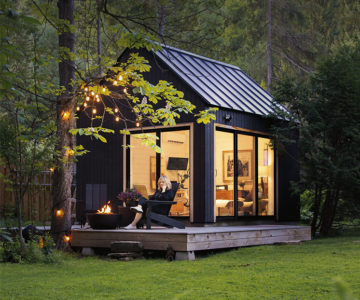Affordable Housing Out of Reach
Owning a home, or even managing rising rental costs, is becoming farther and farther beyond the means of many working people in Headwaters.
Four college diplomas, two jobs, and still only barely makes the rent.
That’s the story for a 47-year-old single mom in Orangeville. She didn’t want her name used in this article, so we’ll call her Denise.
Like thousands of others in our region, the exploding cost of housing means Denise is living all too close to the edge.
Her day begins at 7 a.m. She gets her 11-year-old son ready for school, and then heads to work. In her full-time job, she’s a case manager for seniors, so three days a week she’s either on the road visiting clients or at the office in York Region. On the other two days a week, she works from home.
On the days Denise is away, she leaves for home around 4:30 in the afternoon. She’s home for about an hour – long enough to grab supper – then it’s off to her second job, five nights a week as a cleaner.
With the two jobs combined, she earns about $65,000 a year, a little higher than Orangeville’s lone-parent median income of $62,070.
Denise and her son recently moved, after the building where they had an apartment was sold – ironically, to be turned into a homeless shelter. Her monthly rent went to $2,100 plus electricity from $1,950 a month inclusive. That works out to about 39 per cent of her income, well above the generally recommended 30 per cent maximum for housing expenses.
When she learned she had to move, Denise says, “I put out feelers, but there was nothing available under $2,000. I had to have two bedrooms, and it had to be in the same school district.”
Including first and last months’ rent, and an extra deposit because she has a dog, Denise had to shell out $5,250 before she could move in. She doesn’t blame the landlord, though: “My landlord is really understanding, but the rising cost of everything from labour to building supplies affects them too. Long term, these places have to be updated.”
Most months, Denise says, covering the bills means “robbing Peter to pay Paul.” As she speaks, the frustration comes through in her voice. “I’m not considered to be in poverty. I guess I’m working poor. There’s certainly no money for savings.”
At the same time, she makes too much money to qualify for any benefits. “One month last year I was struggling and called the County of Dufferin for rent help. The maximum they could offer was $545. It was only a quarter of my rent, and as my income is out of the bracket for assistance, I wasn’t eligible anyway.”
She says, “I don’t see an end in sight. It just gets harder and harder every day.”
Queen’s Park, we have a problem
While the term “affordable housing” is sometimes confused with government-subsidized housing, what we’re really talking about is market housing that a majority of people can afford, including a rental supply of the sort Denise needs.
It is also referred to as “missing middle housing.” Until the 1940s, row housing, multi-family homes and clustered housing types were relatively common. Since World War II, however, development has trended towards suburban-style, single-family homes, with zoning regulations that make it difficult to build medium-density, mixed-housing communities. Hence the “missing” middle.

Soaring prices have made finding an affordable home an impossible dream for many working families and young people in Headwaters. Illustration by Charles Bongers.
The lack of local affordable housing can add to poverty and instability for existing residents, hobble local businesses looking to attract new workers, and drive young people out of our communities unless they have the option of living with their parents.
Although the problem has been a long time in the making, the price of housing skyrocketed during the pandemic. According to the Toronto Regional Real Estate Board, the median price of a house in Orangeville in March 2022 was about a million dollars. Averaging the cost of all housing types, prices in Orangeville rose about 36 per cent between March 2021 and March 2022.
The town also led the way when it recorded an eye-popping 51 per cent increase in the price of townhouses – which along with condos, are usually the most affordable style of home. In May, TRREB reported that 278 homes changed hands in Orangeville; of those, only 10 were townhouses and three were condos. The 778 homes that sold in Caledon the same month included nine townhouses and no condos.
Even if you have the minimum down payment of $200,000 lying around, your $800,000 mortgage for that average million-dollar house will set you back about $4,500 a month. To be within the recommended payment maximum of 30 per cent of gross income, including taxes and utilities, you’d need to make $180,000 a year just to keep the mortgage on that run-of-the-mill house above water, and at that you’d be strapped.
Yet the median family income in Orangeville is only $99,840.
Realtor Ross Hughes says there aren’t many first-time buyers in the market these days. “A lot are existing homeowners moving up from the city, who can either work from home, or decide the commute is worth it,” he says. “A few months ago we sold a semi that was listed for $679,900. After 66 showings it sold for $850,000. But the buyers sold their place in Brampton for $1.2 million.” A similar story happens with people from Orangeville who sell and move north to places such as Dundalk.
Though increases in the cost of housing have been especially stratospheric over the past year, prices currently appear to be levelling off, even dropping, as supply has opened up. Part of the reason for that is rising interest rates. However, that cure simply shifts the affordability problem to mortgage rates – a factor that also affects landlord expenses, and could push up rental prices.
A 2022 study by Scotiabank showed that Canada has the lowest per capita housing supply of any G7 country. Two-thirds of that shortage is in Ontario, which is estimated to be 1.2 million homes short of the G7 average. And while there is already a shortage of supply, the province is also projecting significant population growth – an increase of 5.3 million people between 2020 and 2046, to a little over 20 million. Hemson Consulting estimates that 88 per cent of those new residents will locate in the Greater Golden Horseshoe.
While the province mandates growth targets, the municipalities have to figure out how to implement them. Peel Region has directed Caledon to absorb more than 200,000 new residents, tripling the town’s population to 300,000 by 2051, with most settling in the south end. Dufferin is projected to grow by about 50 per cent to 95,000, with most of its growth slated for Orangeville, Shelburne and Grand Valley.
Build, baby, build!
If there’s one thing everyone seems to agree on, it’s the idea that building record-setting numbers of new homes is an essential part of solving our housing woes.
The federal government’s April 2022 budget included a plan to spend $9.5 billion on housing over the next five years, with a goal of doubling the current pace of homebuilding over the next decade to 400,000 units a year. It also provided several measures intended to make it easier for people to save for a down payment.
However, while the federal government directs broad policy, and municipalities wield some influence, it’s the province that pulls the most levers when it comes to where and how housing actually gets built.
The Report of the Ontario Housing Affordability Task Force, released in February 2022, was authored by a group of hand-picked advisers to the Ford government. They were instructed to be bold, and to deliver “actionable, concrete solutions.”
The report paints a stark picture: The average price of a house in Ontario increased 180 per cent to $923,000 in 2021 from $329,000 in 2011. Average incomes grew by only about 38 per cent over the same decade.
The report contains 55 recommendations intended to address the situation. Most notably, it sets a goal of building 1.5 million homes over the next decade, double the current pace of construction. It also calls for new housing to be made the planning priority. Notably missing from the report is any requirement that new developments include affordable housing. (In the recent provincial election, only the Green Party proposed a requirement for at least 20 per cent affordable units in large developments.)
Numerous other recommendations speak to the municipal role in the development process. They include a proposal for a uniform provincial standard for urban design. It would greenlight developments that met the standard, thus limiting the need for municipal council approval or public consultation. It would also curtail the number of “delay tactic” appeals to the Ontario Land Tribunal. In particular, the task force sets out carrot-and-stick measures that would financially reward municipalities that choose to increase their housing supply, and reduce funding to those that do not.
The task force report also calls for waiving the municipal charges paid by developers, which they estimate adds an average of roughly $186,300, or about 22 per cent, to the price of a new home. For a new condo, the average is about 24 per cent. Significantly, development fees for a modest home are the same as for a luxury unit, creating a disincentive for builders to build affordable units.
The Region of Peel’s affordable housing strategy, issued in 2018, contains an interesting examination of the big impact of municipal development and planning fees on the cost of housing. Using a prototype 50-unit apartment building in Caledon, the report’s authors considered providing a 20-year tax exemption, waiving planning and development fees, and altering some development standards, such as parking requirements. They estimated that average rent would fall from $1,941 to about $1,240 per month. Over 20 years, the plan would cost the town and region between $102,000 and $110,000 per unit, mostly in lost tax revenue.
Where will all those houses go?
If housing is the priority, that means other concerns, such as the environment, may take a back seat. The task force made passing reference to protecting environmentally sensitive land and farmland, but organizations such as the Stop Sprawl Peel, the Ontario Federation of Agriculture and the Ontario Greenbelt Alliance among others, fear the affordability issue is a cover for a government whose pro-development agenda has already over-ridden hard-won environmental protections through the use of measures such as Minister’s Zoning Orders, limiting the powers of conservation authorities, and weakening policies to curb sprawl in its update of the Growth Plan for the Greater Golden Horseshoe.
The Ontario Federation of Agriculture estimates that urban sprawl is already consuming 175 acres of provincial farmland a day. And projects like the new Highway 413 set to cross the south end of Caledon mean another 10,000-plus acres of the town’s farmland will be lost to the highway and associated industrial and suburban development.
In Dufferin, Mark Early, CAO of the Town of Mono, read the task force report and was, to put it mildly, peeved. He fired off what he calls a “rant,” outlining his concerns to the Ministry of Municipal Affairs and Housing.
Noting that the task force included no municipal representatives, Early described the report as “skewed toward the development and real estate industry,” and he criticized the province for demanding new housing on lands where its own environmental land-use legislation restricts such development. Mono is a regional, rural town that falls within the land-use plans of the Niagara Escarpment, the Oak Ridges Moraine, the Greenbelt and, as home to the headwaters of three river systems, three conservation authorities, as well as the farmland protection policies of the Ministry of Agriculture, Food and Rural Affairs. In a town like Mono, Early said in an interview, all this regulation “creates a situation where there’s no place left.”
He wrote: “To have a report recommending a scenario essentially bribing municipalities by providing grants and funding to those municipalities who wish to allow residential growth, while penalizing those who don’t, ignores the restrictive planning framework provided to some municipalities through your provincial policies.” Early added, “The largest delays we see at the municipal level are usually related to seeking provincial approvals.”
The nexus of sprawl
In an effort to minimize sprawl, the Housing Affordability Task Force makes numerous recommendations about increasing the density of development within existing urban boundaries, or what’s called “densification.”
It’s an idea that has lots of support from competing interests. In a recent webinar hosted by Stop Sprawl Peel, Rahul Mehta of Sustainable Mississauga called his city “the nexus of sprawl” and he set out how things might be different. “Mississauga made some serious mistakes, but we have the opportunity to learn from them. It’s a lot more expensive to fix after the fact. We have to find a way to bring in these people and that housing, so it doesn’t push out to the north [onto farmland in Caledon].”
Mehta pointed out that Mississauga has a density of about 50,000 people per 3 square kilometres, compared to, for example, Barcelona, Spain, which has a density 10 times higher at 500,000 people per 3 square kilometres– yet is still widely regarded as one of the most beautiful cities on Earth.
One way to increase densification is to permit secondary units, such as basement apartments, in single-family homes. The strategy is viewed as a form of gentle densification that doesn’t affect the character of the neighbourhood and makes better use of existing municipal infrastructure. Although the province allowed secondary suites across the province in 2019, many municipalities still use exclusionary zoning to prohibit them – a practice the task force said should be abolished.
Though most municipalities in Headwaters do allow secondary suites and even second dwellings (subject to maximum sizes and other restrictions), Caledon’s draft affordable housing strategy, presented to council in November 2021, takes the idea a bold step further. It recommends not only allowing two additional residential units (also called secondary suites) in single-family homes, but also requiring at least one additional unit in singles and semis in large residential developments. The proposal is being considered as part of the town’s current official plan amendment process.
Where new construction does take place on undeveloped land, the task force proposed implementing densities higher than traditionally approved, although given the multiyear lag between when a development is planned and when it gets built, there are already many old-style, low-density housing proposals either approved or under construction.
The task force called for densities to be highest close to transportation and transit networks, in part to make transit infrastructure financially viable by ensuring a critical mass of usage. But Jenni Le Forestier, a Caledon resident and member of the Stop the 413 Coalition, says GO commuter service for Caledon remains a pipe dream. In the Stop Sprawl Peel webinar, she quipped, “They call it the Ghost train instead of the GO train. The train isn’t coming until sometime after 2051. Recently Premier Ford said that would be accelerated, but there are no documents to prove this is the case. At the same time, lands along the route have been unlocked for sprawl.”
Higher density? Sure, but not in my backyard
Along with building more homes, densification is another solution on which the task force, affordable housing advocates and environmental organizations agree, so it might have seemed like a sure win. However, in late March, the Ford government released a plan called “More Homes For Everyone,” and it reflects only a few of the task force recommendations – most of them related to streamlining municipal approvals (which amounts to a small part of the overall problem, according to many critics).
The Ford plan says nothing about increasing densities nor sets any target for new home construction.
“I think [the task force] put some very bold ideas forward,” Municipal Affairs and Housing minister Steve Clark told a news conference at the time. But he added, “Municipalities have told us that they’re not ready to implement the ambitious policies from the task force’s report right away.”
As Phil Pothen, a land-use planning and environmental lawyer with Environmental Defence, reflected in the Stop Sprawl Peel webinar, “The government is playing a funny game. They’re getting credit for the task force report without ever saying that they’re going to do any of it.” (The province has established a housing supply working group, set to begin meeting later this year.)
While some municipalities, such Hamilton and Halton, have passed bylaws encouraging densification by prohibiting development outside their urban boundaries, most of the pushback against densification came from suburbs surrounding the Greater Toronto Area, where municipal politicians are pressured by constituents to preserve their single-family neighbourhoods. And those were not people Doug Ford wanted to piss off in the run-up to the June provincial election.
Residents of Orangeville were no exception. A proposal to build 541 apartments, townhouses and stacked townhouses on Hansen Boulevard west of Orangeville Mall, for instance, spawned the Hansen High Density Awareness Group, which even started a Change.org petition called Stop High Density Development in Orangeville.
Although the group raised fair questions about things like schools, traffic and watershed protection, resistance focused primarily on the number of people who would live in the proposed development. It was not a tactic that would win support from the task force, environmental advocates, or in the end, town council, which supported the project.
More recently, a proposal for a nine-storey, 97-unit building on east Broadway has drawn the ire of both members of the public and council, with its sheer height, soaring well above most buildings in town, as the significant bone of contention. And this may be a case where the so-called NIMBYs have a point. As Rahul Mehta said in the webinar, “Controlling sprawl isn’t about building all these huge towers.” Rather, it’s about thoughtful infill to create the missing middle – low-rise, neighbourhood-friendly buildings, and the complete communities, including local jobs and transit, that support them.
A cooling trend
Even as rising inflation continues to put pressure on other consumer expenses, realtor Ross Hughes says the local housing market has cooled somewhat from its overheated state last winter. April 2022 statistics show average selling prices have dropped 10 per cent from those in January, and have come down more since. Though he remains optimistic that “the sky isn’t falling,” he notes, “With Covid, the market went bananas.”
Hughes also stresses the relationship between inventory, selling price and days on the market. “In January, there was an average of only 11 houses listed in Orangeville,” he says. “That’s why we were seeing bully offers, places selling over asking, and they were being snapped up so quickly. There was nothing to buy.”
As of mid-May, there were 87 houses listed, a number Hughes describes as about three months of inventory.
What brought about such a dramatic swing? “In February, when the Ukraine war broke out, many buyers found the unrest scary, and some sat back,” he says. “Rising interest rates have given others pause. At the same time, potential sellers started getting word of the crazy numbers, and the market traditionally gets busier in spring anyway, so inventory started picking up.”
Mono’s Mark Early highlights another factor: “It used to be, the big thing was, ‘Are you within commuting distance of the city?’ Since the pandemic resulted in so many people working from home, now the question is, ‘How good is your internet?’ That’s creating housing demand farther and farther away from Toronto.”
The bank of Mom and Dad – and Grandpa, too
While affordable housing policy wends its way through all the political machinations, some young people are turning to a more personal solution.
Hughes says few first-time buyers are entering the market, but for many of those who are, the money comes from family. “We’ve had parents outright buy houses. I’ve also had parents with lots of equity in their homes refinance so they can give the money to their kids.”
That was the case for a young Orangeville couple, who, like Denise, wish to remain anonymous, so we’ll call them Emily and Ben.
In their late 20s, they’ve been married a year and a half. Both are only four years into their careers, and both are engineers – she civil, he mechanical. Each of them earns what Emily describes as “decent salaries.”
They began looking into buying their first home in the summer of 2021, and got pre-approved for a $650,000 mortgage, but, Emily says, “We realized we couldn’t do it. There was nothing for that much money within driving distance of our jobs in the city.”
Enter Ben’s grandfather, and his gift of $300,000.
Last December, the couple shifted their initial focus from Bolton, where everything was still too expensive despite the gift, and bought a 30-year-old, three-bedroom detached house in northwest Orangeville. They packed up their rented basement apartment before the deal closed in March. They paid $950,000.
The couple plans to stay in their home long-term, so Emily is not concerned about the risk of a market correction. “We knew the market wouldn’t sustain the crazy increases, and we knew the price could stagnate, but at the same time, we’re okay. It’s within our means.” They also benefited from the fact that, at the time, interest rates were still very low, Emily says, “So we got a good five-year rate.”
As they settle in, Emily and Ben are adapting to life as homeowners, including some of the nuisances. Even at $950,000, their house needed a new roof. The air conditioning is iffy, and the washer had to be replaced. “We like it,” says Emily, “but it’s a learning curve.”
Emily acknowledges that without the generosity of Ben’s grandfather, they wouldn’t have been able to buy, or at least it would have taken them years to save a down payment. And she is profusely grateful for that: “We are so blessed to have had help.”
For young people who don’t have access to such help, the dream of home ownership remains elusive, and for hardworking moms like Denise, the waiting and the anxiety continue.
Related Stories

How We Work from Home
Sep 18, 2020 | | CommunityOnce the pandemic is over, many people intend to keep working from home – if only their lousy rural internet will co-operate.

Home Sweet Office
Sep 18, 2020 | | Editor’s DeskAt this magazine, our work culture is based on trust and respect.

The Need for Speed
Jun 17, 2014 | | CommunityWe’ve been hearing about rural broadband for more than a decade. So where is it?

The Backyard Office
Jun 24, 2022 | | CommunityWork-from-home studios are having a moment, driven in part by pandemic trends; newbies and veterans alike speak to the merits of a space of one’s own.











